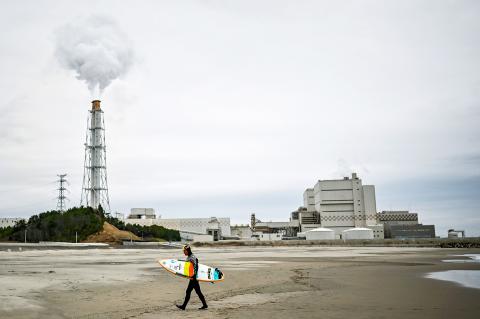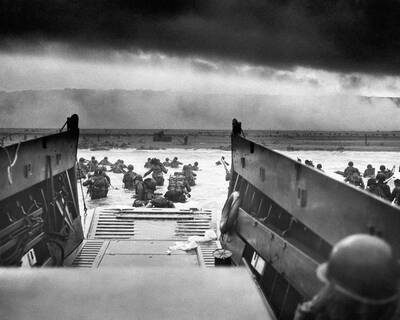Every morning, come rain or shine, 64-year-old Koji Suzuki grabs his board and checks out the surf crashing onto the Fukushima coastline, some of the best rollers in Japan.
Suzuki’s local beach, Minamisoma, is around 30km north of the crippled Fukushima Daiichi nuclear plant and he still has vivid memories of March 11, 2011, when a towering tsunami triggered by a magnitude-9.0 quake surged inland, ravaging the facility.
The ruthless waves also wiped out his entire coastal neighbourhood of some 70-strong households, including his surf shop. He fled, leaving everything behind except two shortboards that happened to be in his getaway car.

Photo: AFP
“I lost my house, my job and my shop. My mother died while evacuated, and my father followed within months. I lost everything. Except my surfing,” he said.
When he returned that summer, the beach was littered with debris from broken houses.
The meltdown at the Fukushima Daiichi plant, the worst nuclear accident since Chernobyl, was still causing radiation to leak into the environment, forcing around 160,000 people to evacuate.
But Suzuki was determined to get back into the water, where several currents collide to make it one of the best surfing spots in the country.
“It was a heartbreaking view, but the ocean was there just like before... I thought if I didn’t go into the water now, this shore would be dead forever,” he said.
After ensuring radiation levels were not dangerous, he stepped back into the waves — as rescuers were still raking the beach for the missing and their bodies. That day marked the resumption of his decades-long surfing passion.
“I surf about 250 days a year,” said the veteran, emerging from the water, board under his arm.
“I take a break only on New Year’s Day and the day after. The rest of the year, I come to see the ocean every morning.”
‘FUKUSHIMA WILL NEVER RECOVER’
Nine years later, Prime Minister Shinzo Abe is keen to use the upcoming Tokyo Olympics to showcase Fukushima’s recovery, planning to start the Japan leg of the torch relay from there.
Abe’s government also lifted an evacuation order for parts of Futaba, one of two towns hosting the nuclear plant, to allow the torch relay to go through.
For 2020, surfing is making its Olympic debut in part of a drive to make the Games more interesting for young people. The event will be held on Tsurigasaki Beach, in Chiba, northeast of Tokyo.
Suzuki said he appreciates that Fukushima may receive a boost from being portrayed in the media as “safe” but does not believe in the “Recovery Olympics” touted by the government.
“Fukushima will never recover,” he said. “I can never go back to the same place where I used to live and run my shop... Fukushima will be stigmatized in history, forever.”
And despite government efforts to renew its image, the Fukushima nuclear crisis is far from over. Japan is agonising over what to do with around one million tonnes of contaminated water stored in tanks at the plant site. The radioactive liquid, from cooling water, groundwater and rain that seeps into the plant daily, is filtered to remove most of the isotopes but one — tritium.
The world’s nuclear watchdog, IAEA, has backed Japanese plans to release the water into the ocean, describing it as a practice “done elsewhere.”
But some of Japan’s neighbors, including South Korea, have raised questions about safety, while local fishermen are concerned about reputational risks.
Hideki Okumoto, a professor at Fukushima University who has examined radiation levels onshore, said safe data do not necessarily lead to people feeling safe.
“The radiation levels here are no different from those before the nuclear accident,” he said. “We just need to keep checking and disclosing data in a timely fashion, showing they are no higher than (safety) standards.”
‘SALTY SEAWATER’
Suzuki does not doubt the science but opposes plans to release the water, saying the reputational risks could be “a drag” on his homeland.
“We still have great nature left here, especially for surfing. I like this place more than anywhere else. I like the good people here, I feel comfortable,” he said.
“I just want to share this feeling with people who feel the same way. That is good enough for me.”
Last summer, the city of Minamisoma officially opened Suzuki’s home beach to visitors for the first time since the accident.
“It was a wonderful feeling to see children frolic in the rough water of the shore. They hadn’t even tasted salty seawater until then,” he said.
Suzuki, who will turn 65 later this month, hopes his passion for surfing will never again be interrupted. “When I turn 70 and a shortboard becomes too tough to manoeuvre, I am thinking about switching to a longboard.”

It is jarring how differently Taiwan’s politics is portrayed in the international press compared to the local Chinese-language press. Viewed from abroad, Taiwan is seen as a geopolitical hotspot, or “The Most Dangerous Place on Earth,” as the Economist once blazoned across their cover. Meanwhile, tasked with facing down those existential threats, Taiwan’s leaders are dying their hair pink. These include former president Tsai Ing-wen (蔡英文), Vice President Hsiao Bi-khim (蕭美琴) and Kaohsiung Mayor Chen Chi-mai (陳其邁), among others. They are demonstrating what big fans they are of South Korean K-pop sensations Blackpink ahead of their concerts this weekend in Kaohsiung.

Taiwan is one of the world’s greatest per-capita consumers of seafood. Whereas the average human is thought to eat around 20kg of seafood per year, each Taiwanese gets through 27kg to 35kg of ocean delicacies annually, depending on which source you find most credible. Given the ubiquity of dishes like oyster omelet (蚵仔煎) and milkfish soup (虱目魚湯), the higher estimate may well be correct. By global standards, let alone local consumption patterns, I’m not much of a seafood fan. It’s not just a matter of taste, although that’s part of it. What I’ve read about the environmental impact of the

Oct 20 to Oct 26 After a day of fighting, the Japanese Army’s Second Division was resting when a curious delegation of two Scotsmen and 19 Taiwanese approached their camp. It was Oct. 20, 1895, and the troops had reached Taiye Village (太爺庄) in today’s Hunei District (湖內), Kaohsiung, just 10km away from their final target of Tainan. Led by Presbyterian missionaries Thomas Barclay and Duncan Ferguson, the group informed the Japanese that resistance leader Liu Yung-fu (劉永福) had fled to China the previous night, leaving his Black Flag Army fighters behind and the city in chaos. On behalf of the

The captain of the giant Royal Navy battleship called his officers together to give them a first morsel of one of World War II’s most closely guarded secrets: Prepare yourselves, he said, for “an extremely important task.” “Speculations abound,” one of the officers wrote in his diary that day — June 2, 1944. “Some say a second front, some say we are to escort the Soviets, or doing something else around Iceland. No one is allowed ashore.” The secret was D-Day — the June 6, 1944, invasion of Nazi-occupied France with the world’s largest-ever sea, land and air armada. It punctured Adolf